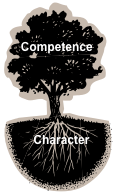About 1-1/2 years ago I went to my dentist for a regular check-up and teeth cleaning. Toward the end of the visit he gave me a wake up call when he proclaimed "your teeth are going to fall out!" He was being dramatic to make this point: I needed to floss. You see, even though I was a fabulous brusher, I was absolutely horrible at flossing. I had never developed the habit and I was paying the price.
What followed over the next eighteen months was a flossing adventure that provides a wonderful metaphor for strategic planning. In fact, the lessons I learned were remarkably similar to some of the critical strategic planning lessons I share with our customers...
Lesson 1: Use the Right Tool. I walked out of my dentist's office that day with this flossing tool in hand. Quite simply, this ingenious device has made all the difference. What used to take several frustrating and messy minutes of me fumbling around with dental floss now took about 30 seconds. In the strategic planning world, you need the right tools too. Like Mission Met Center, our software that makes it easier to create and track your strategic plan.
Lesson 2: Create Urgent Accountability. When I left my dentist's office I had a mandate to floss. I also had an appointment to return in three months to assess my progress. Knowing that I had 90 days to get my flossing act together created an urgent sense of accountability. Frankly, I didn't want to let my dentist and his hygienist down. The result? I created a new flossing habit that had evaded me for over 40 years. That type of accountability -- short-term due dates and reporting progress to others -- is the secret sauce to catalyzing your strategic planning success.
Lesson 3: Praise Creates Momentum. At my 90-day visit I was praised for the obvious improvement in my teeth and gums. I still had a long way to go but the positive feedback I received helped reinforce my new habit. The same goes for strategic planning. So often teams make the mistake of focusing on the goals they didn't hit. I've found that my clients that are the most successful in implementing their plans focus, instead, on what they do right. That emphasis creates a positive strategic planning culture that encourages even more involvement and effort.
___________________________________________________
I'm proud to say that today my teeth and gums are the healthiest they've been in decades. I floss twice per day and my dentist is thrilled with my turnaround. And, oddly enough, the experience has even helped me reinforce my perspectives on strategic planning!






